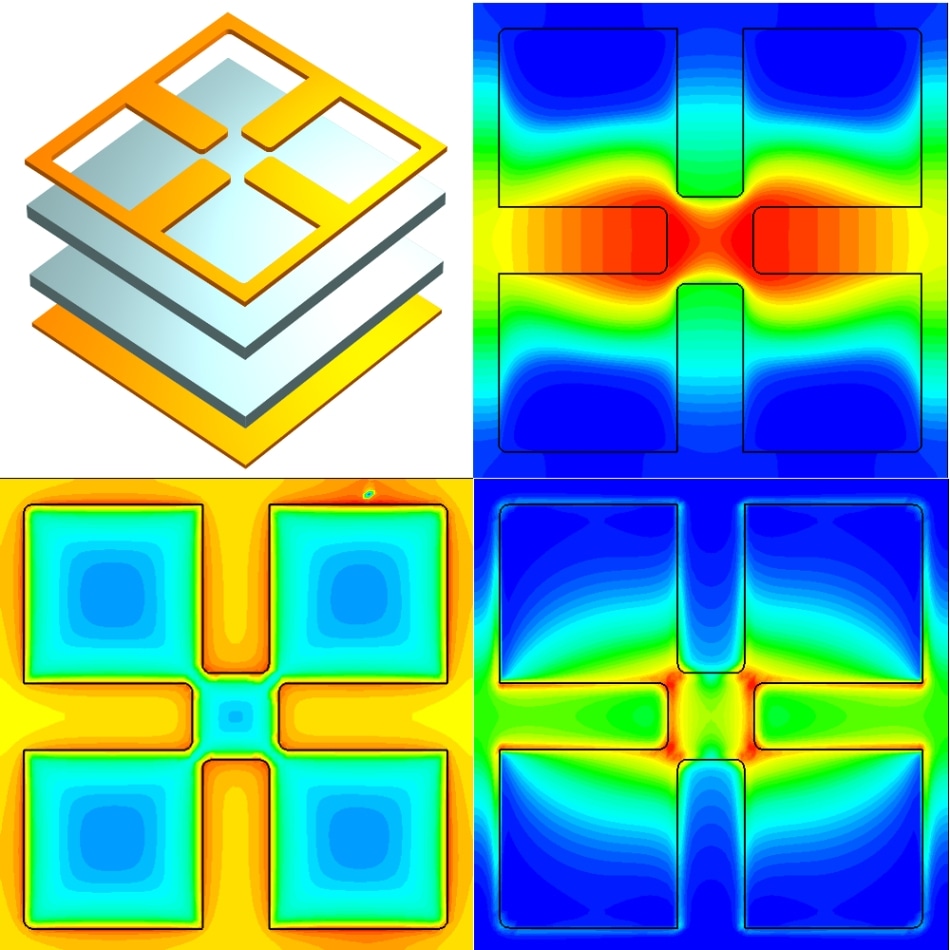Apr 10 2017
Engineers and materials scientists have developed a fast and highly sensitive sensor capable of detecting specific electromagnetic wavelengths while on the move.
 A layer-by-layer look at the new metamaterial infrared detector, with simulated views as to its temperature distribution (top right), electric field (bottom left), and how it absorbs power (bottom right). (Credit: Willie Padilla, Duke University)
A layer-by-layer look at the new metamaterial infrared detector, with simulated views as to its temperature distribution (top right), electric field (bottom left), and how it absorbs power (bottom right). (Credit: Willie Padilla, Duke University)
Using this novel technology, the health of large fields of crops could be assessed and plastics could be rapidly sorted out for recycling. Active monitoring of vast areas for natural gas or methane leaks is another potential application of this prototype detector jointly developed by Duke University engineers and SRICO, an optoelectronic materials company. This breakthrough device is superior to existing competitive products in terms of weight, size, speed, power, and cost.
The researchers have built their new sensor using metamaterials, which are engineered structure composed of carefully engineered repeating cells capable of interacting with electromagnetic waves in aberrant ways. They combined simple metal patterns with very thin slices of perfect crystals to build a streamlined device capable of detecting invisible infrared signatures released by different types of plastics, gases, and other sources.
The study results have been reported in the Optica journal.
The benefit of using metamaterials is that different components required in a detector can be combined into one feature. That simplification gains you a lot of efficiency.
Willie Padilla, professor of electrical and computer engineering at the Duke University.
A typical thermal detector involves absorption and conversion of infrared light waves into heat using a black substance, generally soot and creation of an electrical signal by conducting the heat to a separate component. The electrical signal generated is then read out. This configuration has speed limitations and specific wavelengths can only be distinguished when filters or a complicated system of moving mirrors are overlaid.
These issues can be overcome by using the new metamaterial sensor.
A pattern of gold is placed over lithium niobate crystal in each small section of the sensor. This pyroelectric crystal generates an electrical charge upon getting hot. Like cutting a slice of a cheese from a block, SRICO engineers peel an extremely thin slice of crystal with a thickness of around 600 nm using an ion beam. This technique minimizes background noise as potential defects are eliminated in the crystalline structure. It also produces a slice thinner than other methods, enabling the crystal to heat up rapidly.
Generally, this crystal is thin enough to allow the light to traverse without being absorbed, but the researchers modify the top gold layer into a pattern. The combination of this metal pattern and the properties of the crystal eliminates the use of separate filters as only a specific range of electromagnetic frequencies can be absorbed by the pixel.
The gold also eliminates the need for separate electrical leads by transmitting the signal generated by the crystal when heated up to the amplifier of the detector.
These designs allow this technology to be 10 to 100 times faster than existing detectors because the heat is created directly by the crystal. This lets us create devices with fewer pixels and also presents the ability to sweep the detector across an area or capture images in motion.
Jon Suen, a postdoctoral associate in Padilla’s laboratory.
This is such a good marriage of technologies. Working with Duke has been one of the most ideal situations I’ve had with technology transfer. We can focus on making the material and they can focus on the device structure. Both sides have been contributing with a clear product in mind that we’re now working on marketing.
Vincent Stenger, a coauthor on the paper and engineer at SRICO.
By redesigning the gold pattern details, the researchers are able to fabricate the sensor to determine any specific range of electromagnetic frequencies.
A single-pixel prototype has already been created as a proof of concept by Stenger and his collaborators at SRICO. At present, the researchers are working to obtain a follow-on government grant or funding from industry investors.
The research team is optimistic, as its prototype detector is advantageous in many ways over existing technologies. With a fast detection time, the device could rapidly scan areas for natural gas or methane leaks. Its simple design makes it easy to carry into agricultural fields to monitor the health of crops.
You could even make this into a low-cost lab instrument for spectroscopy for medical samples. I’m not sure what the eventual price point would be, but it’d be a lot less than the $300,000 instrument we currently have in our laboratory.
Padilla.
The U.S. Army Research Laboratory (W311SR-14-C-0006) supported this research.